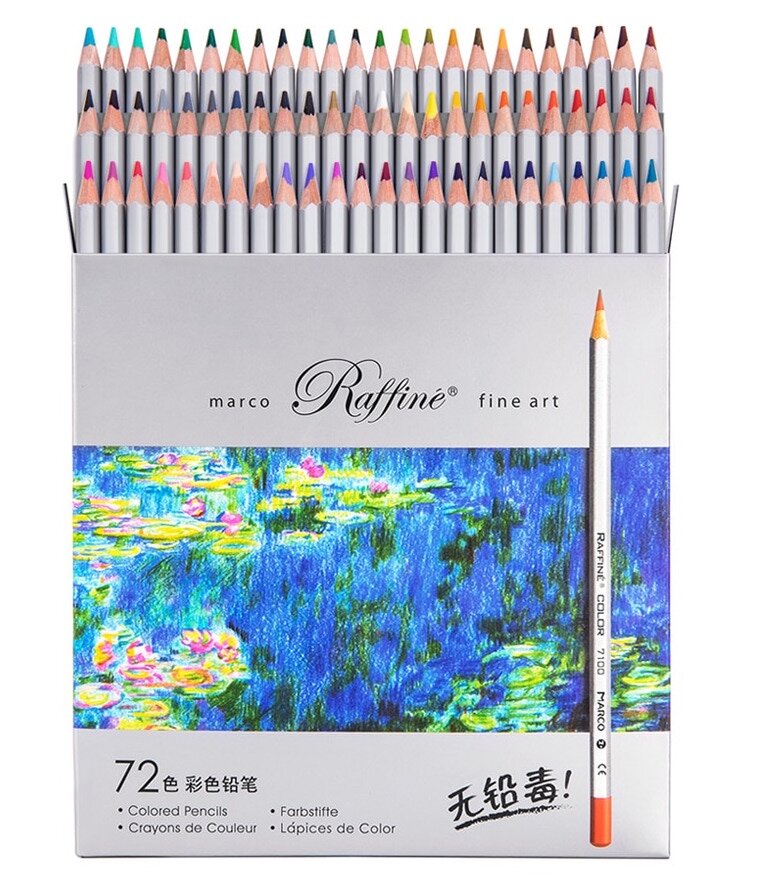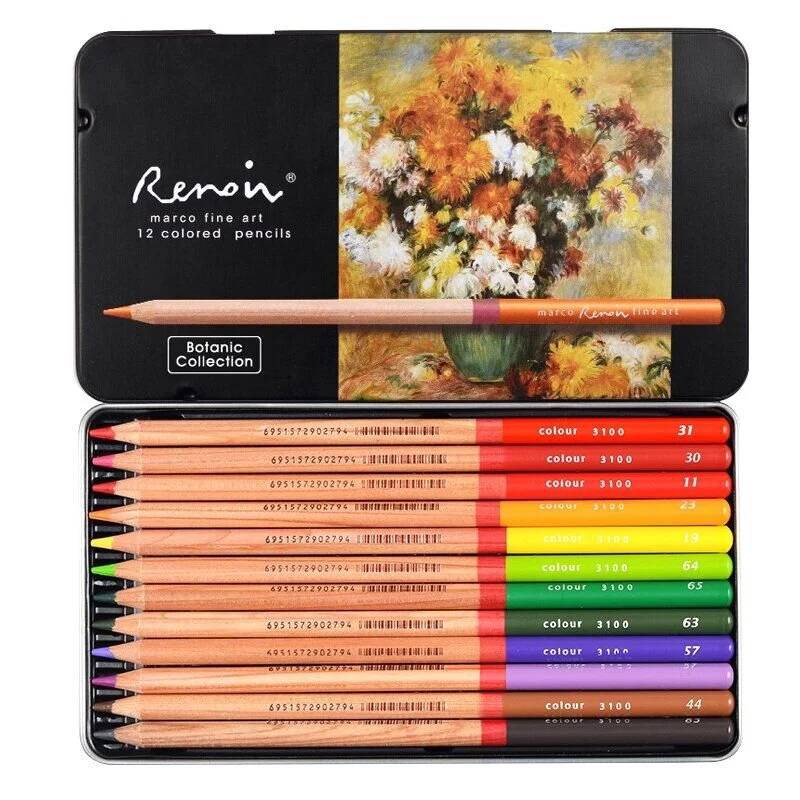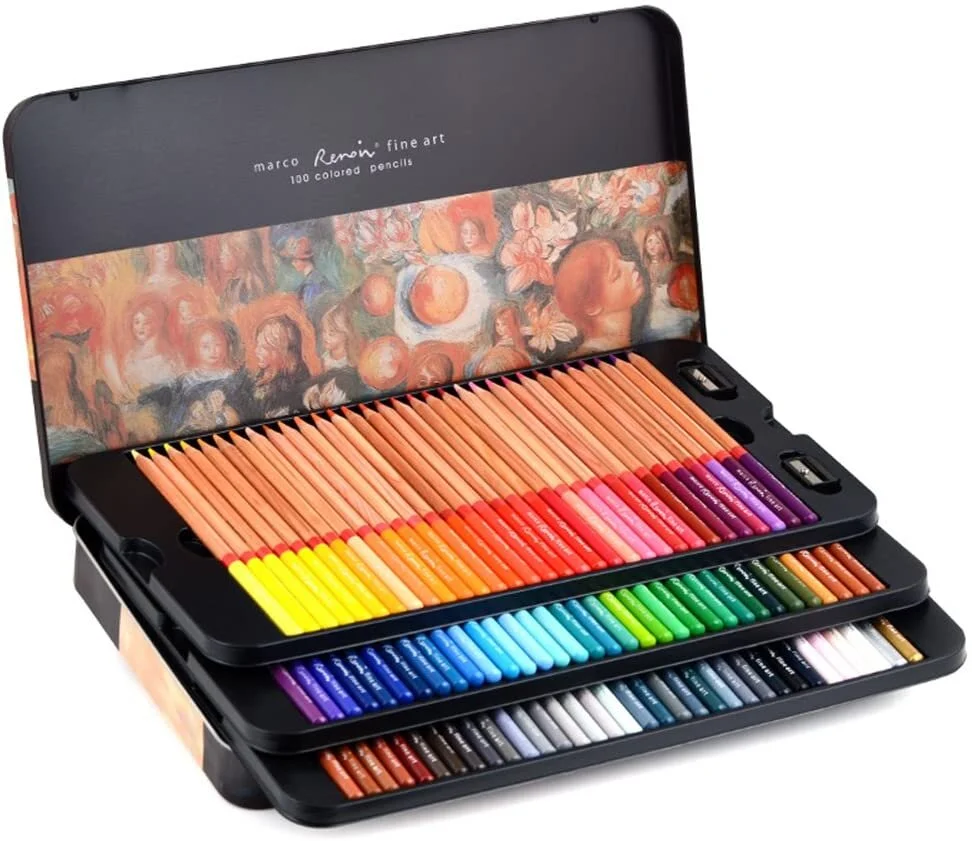Marco Raffine Colored Pencil Review
Marco Raffine Colored Pencil Review
In this review we take a look at the Marco Raffine Fine Art Colored Pencils. Not long into my endeavour to review art products and in particular colored pencils, back when the channel was called Coloured Pencil Reviews, I reviewed the Marco Renior Colored Pencils. Of all the colored pencils I have reviewed in the past four or five years, I think the Marco Raffine has turned out to be the most challenging and so the most detailed.
After reviewing the Marco Renior, I of course knew about the Marco Raffine but there was just something about the pencils that didn’t appeal to me; I knew I would eventually have to review them, but I was certainly in no rush to do so. I had heard a lot of mixed talk about the Raffine, a lot of which said that the Raffine were the better pencil of the two sets, which intrigued me as I personally really enjoyed using the Renior. If you would like to watch my YouTube video review or read about the Marco Renior Colored pencils simply follow the links.
To be honest it is quite difficult finding out information about the actual company, from what I can gather, Marco Colored Pencils were actually started in the United States quite a while back but then a company in China purchased the brand. From then on the Marco Colored Pencils have really been classified as a Chinese Colored Pencil Company.
Marco Raffine Colored Pencil Sets Available.
When you look on Amazon here in the UK, US or Europe, and you search for Marco Raffine you will not actually find much in the way of variety in sets. I do have to say however, at the time of writing this review, Jan 2021, the world is a year into a terrible global pandemic which is effecting everything we know, including art sales, movement of art products around the world etc. During more normal times things might be different but I am going to stick to the facts as they appear in the right here and now.
The Marco Raffine sets are available in sets of 12, 24, 36, 48 and 72; the sets come in various packaging including a 72 set in a canvas wrap. For the most part, and one of the reasons I was not too enamoured about the Marco Raffine, when searching for the pencils you will see mostly the 72 sets in a cardboard box or the Canvas Roll.
The smaller sets of 12, 24, 36 and 48 also come in the same style cardboard box as displayed above, however you can, if you are lucky find the Marco Raffine in tins. I myself have only found this via lengthy research of the brand and checking out stores in Asia.
In exactly the same view as the first paragraph in this section, if you search for the Marco Raffine or Renior colored pencils on some of the Asian shopping sites, you will see a completely different take on these pencils to the one we here in the West are painted with. There are lots of Marco brands, Artist quality versions of the pencils in the form of the Marco Tribute. I will be doing my very best to get hold of these sets in order to make sure I am delivering the most diverse and detailed catalog of colored pencil reviews online.
Marco Raffine Colored Pencil Characteristics
I think for me personally, and quite wrongly I might add, I viewed the Marco Raffine as a colored pencil way down the the companies pecking order based on the packaging that the pencil is in. I know that the packaging has nothing at all to do with the product performance, nevertheless, for some reason I could never get my head around the fact that the pencil packaging let the product down, even though they are sold in Tins, just not very often in the West.
As is the case on so many occasions, my first impressions of the Marco Raffine were quite a bit off. I always have these preconceived ideas about a product which I 90% of the time get wrong which is why I put so much effort into testing and demonstrating the products. I purchased the 72 set of Marco Raffine Colored Pencils to review and display the full palette of Raffine.
The first impression I got about the actual pencils when I held them individually was that they are a well balanced and weighted pencil. They might look cheap in the cardboard packaging but they certainly don’t feel cheap in the hand. The barrel of the Marco Raffine is hexagonal in shape which I know a lot of colored pencil artists love due to the lack of rolling about on the desk you get with them.
All hexagonal barrels of the Marco Raffine are lacquered silver and they display a girth of 7.2mm which is quite slimline in comparison to many other pencils we use. The slender 7.2mm barrel holds an accurately slim 3.2mm core, which again is a little slimmer than most.
Along one side of the Marco Raffine barrel is printed in clear black print the pencil brand “Raffine” this is closely followed by “Color 7100”. Moving slightly further along the barrel is clearly printed the companies name and logo “Marco”
Finally, toward the very end of the barrel is a number which corresponds to the actual pigment core. On the very end of the barrel is a half inch pigment identifier which, as in so many cases regarding colored pencils, does not exactly match up with the core pigment.
There is no pigment names anywhere on the barrel of the pencils or on the cardboard boxes. In cases such as this I would ordinarily contact the company directly and ask them questions but I have not been able to locate an English talking line of communication to fulfil this end of the review. As I have not been able to get hold of a tin of Marco Raffine, I am unable to talk about any pigment names that may or may not be present there.
For so many colored pencil artists it is important to have the pigment names somewhere, be it on the barrel, a color chart on the back of the packaging, slipped into the tin or box or even on the companies website, none of which I have been able to locate.
I did of course create my own swatch which will help you to visually see the entire palette range, of course the only reference to the pigments is the numbers printed on the barrel. I have seen many talented colored pencil artists create their own names for the pigments and apply them to the barrels which in the long run helps the artist when selecting a palette in accordance to the subject you wish to draw with them.
Marco Raffine Colored Pencil Prices
As I mentioned at the beginning of the review, due to the COVID 19 pandemic that has effected us all, even stores such as Amazon are running low on stock and so many products are currently unavailable. As I do with all of the reviews on The Art Gear Guide, I will update prices as and when things change.
Here in the UK, a 72 set of Marco Raffine in the cardboard box will cost you approximately £25.99 , oddly enough the 72 set in the Canvas Wrap, which is arguably a more attractive deal will cost you slightly less at £23.99. For the 48 set of Marco Raffine you can expect to pay approximately £16.99
For colored Pencils artists in the States, you can expect to pay the following for the current sets available. for the 72 Set in the cardboard box you will pay $38, for the same 72 set of Marco Raffine in the Canvas Roll you will pay £29.99 and finally for the 48 set of Marco Raffine in the Canvas Roll you will pay approximately $29.99
For colored pencil enthusiasts in Europe, if you would like to purchase the 72 set of Marco Raffine in the Cardboard Box you will pay €25.99, for the same 72 palette in the Canvas Roll you will pay €29.99 . Unfortunately I was unable to locate the 48 set of Marco Raffine and so this is a section of the review that I will have to amend as and when I can.
Marco Raffine Colored Pencil Performance
I mentioned at the beginning of this review that I think it may be the most detailed of all my reviews and I only say this because of the various papers I tested the pencils on, I even had to purchase a new block of paper and wait a day or so for the delivery before I could continue.
As always the first thing I do with all products I review is complete a swatch so that I can see the palette and determine from there what I am going to draw. I completed the swatch on the Clairefontaine Paint On Mixed Media Paper, which is a cheap paper but really decent quality.
When I was completing the swatch the pencils just didn’t feel that good on the paper and this paper is smooth but with a little bit of tooth. I was a little bit disappointed with the selection of greens in the set, but overall it is a nice selection of pigments.
I then started to draw a tropical leaf on the same Clairefontaine Paint On Paper, however I stopped the drawing after about half an hour of work. This was mainly due to the greens just not looking right for what I was trying to create and a little bit to do with the paper.
I then started to draw an apple, again and very stupidly on the Clairefontaine paper, but after almost finishing the piece, I just knew 100% that the paper was not right for the pencils and so I had to started again. It was at this point that I took out my Strathmore 400 Series Mixed Media paper and drew the same apple on this. things started to look better, and the artwork I have submitted for the speed drawing is the one on the Strathmore 400 Series Mixed Media.
Apple On Strathmore 400 Series Mixed Media
Nevertheless, half way through the drawing , I ordered a block of Strathmore 300 Series Bristol Velum. I have quite a few other papers under my desk but no Velum and I wanted to use this paper for my layering and blending test. I had finished the art work by the time the new paper arrived and so I started on the tests.
I knew immediately that things were going much better on the Strathmore 300 Series Bristol Velum, which is a mystery to me because although the Velum does have a little bit of tooth, it is not terribly different to the Mixed Media papers I had previously tried. The first test I completed was the layering test and the Marco Raffine Colored Pencils performed really well on this test.
They are not hugely pigmented pencils and only when the heavy applications were applied could the real potential of the pigments be exposed. Although the Marco Raffine layered really well, I don’t think it drew out the strength of pigment too well.
Next was the blending and as you can see from the results, the Marco Raffine blend beautifully, clearly creating a third color when required. The actual feel of the core on paper is really tough to describe, the Marco Raffine has a medium hard core, they are not terribly crumbly but they will with a little bit of extra pressure. They are not a terribly soft core on the paper but they are not hard to the point they are scratchy. If you are used to the Marco Renior, the Raffine are certainly harder than the Renior and not quite as pigmented in my opinion, but the Raffine are definitely much better for layering.
Before Using Zest-It Odourless Mineral Spirits
After Zest-It Odourless Mineral Spirits
My next test was testing the Marco Raffine pigment reacting to Odourless Mineral Spirits, I personally don’t use OMS to blend, however I know many artists do and so it is important I add this to my testing process. The best thing to do is check out my YouTube Video Review of the Marco Raffine were you can see the OMS actually working and see how the pigment reacted. You can also take a look at the before and after image I have provided.
My final test is the Marco Raffine on Black paper, this is such an important test because there are so many CP artists that create the most amazing work on toned paper or black paper. This test shows just how opaque or translucent the pigment within the pencils are
In this test you can see that the yellow and green are more translucent, allowing for the black pigment of the paper to show through. The Red and Blue however are slightly more opaque, the white pencil was surprisingly opaque but as you can see from the image it came out well on the black paper.
Marco Raffine Lightfast Information
The Marco Raffine fall in-between a budget pencil and student grade pencil, it is becoming increasingly difficult to categorise a budget pencil given that so many colored pencil manufactures are increasing their prices significantly.
That being said, regardless of pricing and the small increase, there is no lightfast information at all for the Marco Raffine. They are a pencil perfect for the Adult Colouring Book Artists as many of the good quality colouring books have paper similar to the velum of the Strathmore 300 Series, just not as thick.
Marco Raffine Conclusion
It did take me a while to warm up to the Marco Raffine and I am not too sure if that was an underlying subconscious thing given my lack of haste in reviewing, dating right back to when I first used the Marco Renior Colored Pencils.
Once I started to use what I considered the right paper, I felt like I was using a totally different pencil. It is important to note, that as with all the products I review on The Art Gear Guide, the right paper for me may not be the right paper for you, even though we are talking about the same pencils. There are so many factors as to why this is the case, the different pressures we all use on our pencils, the genre of art we are drawing and so much more.
the reason why I display the differences in my reviews, is so that, you guys as the artists, can enlarge the images I provide and inspect them and see if the results line up with the type and style of art you enjoy creating.
The overall palette of the Marco Raffine is pleasant but I wasn’t too thrilled with the selection of greens, I found there to be too many blue greens. Again this is only a personal preference but as you can see from the swatch image, the selection of color is well thought out.
On all of the tests I performed the Marco Raffine held up well and delivered some excellent results, such as the blending test, having the ability to create a completely different green using the Blue and Yellow in the test.
As always I have provided a YouTube Video review of the Marco Raffine to watch all you have to do is follow the links. there is also a YouTube Video Speed Drawing of the artwork I created using the Marco Raffine, a video like this will help you see the pencils in action so to speak. Finally, if you would like to see the results of the pigment on the paper, I have provided a page with still images of the artwork at various stages of completion, simply select the image that interests you to enlarge it and see in finer detail how the pigment lays down on the paper.



















